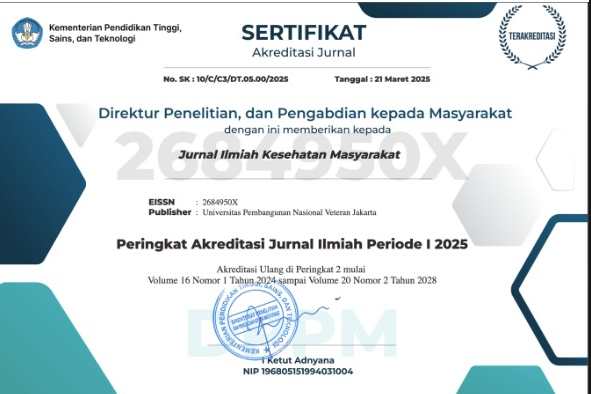Studi Kualitatif Perilaku Keselamatan dan Kesehatan Kerja (K3) Petugas Instalasi Gizi Rumah Sakit pada Program Pencegahan Infeksi
Abstract
Latar belakang: Infeksi yang terjadi saat seseorang menjalani perawatan medis saat ini menjadi perhatian banyak rumah sakit. Selain faktor resistensi kuman, perilaku petugas medis merupakan faktor risiko yang diduga menyebabkan kejadian tersebut. Perilaku yang dimaksud pada umumnya terkait dengan sanitasi dan higiene pribadi serta aspek keselamatan dan kesehatan kerja (K3). Penelitian ini bertujuan untuk menganalisis perilaku K3 staf instalasi gizi rumah sakit dalam menunjang program Pencegahan dan Pengendalian Infeksi (PPI).
Metode: Penelitian dilakukan secara kualitatif dengan teknik observasi dan wawancara mendalam. Informan dipilih dengan teknik purposive dari populasi terjangkau. Informan utama sejumlah 6 orang dan informan triangulasi sejumlah 3 orang.
Hasil: Pengukuran suhu tempat kerja menunjukkan bahwa area produksi menunjukkan suhu tertinggi dibanding area pemorsian. Mayoritas informan memiliki pengetahuan dan sikap yang baik terhadap aspek K3 di tempat kerja. Hasil pengamatan menunjukkan bahwa praktik K3 petugas belum dilakukan sesuai standar. Penggunaan APD dan kepatuhan terhadap prosedur yang aman menjadi aspek yang paling banyak teramati.
Kesimpulan: Diharapkan institusi rumah sakit dapat melakukan brifing dan evaluasi terarah terhadap pelaksanaan safe food handling dan K3 untuk pencegahan infeksi.
Kata Kunci: Infeksi nosokomial, Instalasi Gizi rumah sakit, Lingkungan Kerja, Perilaku K3
Qualitative Study of Safety and Health Behavior of Hospital Food Handler Towards Infection Prevention and Control Program
Background: Hospital associated infection was considered as the most common threat for hospitalized patient. Indonesia Ministry of Health's had officially issued the infection prevention program in 2017. Nowadays the implementation was considered to be evaluate facing the new global standard of hospital safety and facility management. This study aimed to analyze health and safety behavior amongs hospital kitchen staff in supporting the Infection Prevention and Control program (IPC).
Method: The research was conducted qualitatively by observation and in-depth interview method. Informants were selected using the purposive technique from targeted population. The main informants were 6 people of food handlers and the triangulation informants were 3 people from kitchen head and supervisors.
Result: Workplace indoor temperature of production area was 310C. This was relatively high compared to Indonesian Regulation. In-depth interview result indicate that majority of informants have good knowledge and attitude towards personal hygiene and sanitation. The observations showed that some participants did not comply safe operational procedure. The use of PPE and their compliance with safe procedures are the most important observed aspects.
Conclusion: It is expected that hospital institutions can conduct routine briefing and make deep evaluation of the safe food handling practice, safety procedure and infection prevention thoroughly.
Keywords: Food safety, hospital acquired infections, hospital kitchen, safety behavior
References
Pinchuk I V, Beswick EJ, Reyes VE. Staphylococcal enterotoxins. Toxins (Basel). 2010 Aug;2(8):2177–97.
Chambers HF. The changing epidemiology of Staphylococcus aureus? Emerg Infect Dis. 2001;7(2):178–82.
Dagnew M, Tiruneh M, Moges F, Tekeste
Z. Survey of nasal carriage of Staphylococcus aureus and intestinal parasites among food handlers working at Gondar University, Northwest Ethiopia. BMC Public Health. 2012 Jan;12(1):837.
CDC. Morbidity and Mortality Weekly Report ( MMWR ) Incidence and Trends of Infection with Pathogens Transmitted Commonly Through Food — Foodborne Diseases Active Surveillance Network , 10 U . S . 2013.
Lund BM, O‘Brien SJ. Microbiological safety of food in hospitals and other healthcare settings. J Hosp Infect. 2009 Oct;73(2):109–20.
Supraptini, Seregeg IG BS. Kejadian Keracunan Makanan dan Penyebabnya di Indonesia 1995-2000. J Ekol Kesehat. 2002;1(3):127–35.
T. H Chen JMC. Bacterial Foodborne Outbreaks In Central Taiwan 1991-2000. J Food Drug Anal. 2003;11(1):53–9.
Elizabeth P. NORMS AND STANDARDS FOR ENVIRONMENTAL HEALTH AND OCCUPATIONAL HYGIENE AT DISTRICT HOSPITALS. Durban, South Africa; 2001.
Tawatsupa B, Yiengprugsawan V, Kjellstrom T, Berecki-gisolf J, Seubsman S, Sleigh A. Association between heat stress and occupational injury among Thai workers: Findings of the Thai cohort study. Ind Health. 2013;51:34–46.
Neilsen D, Austin J. Behavior-Based Safety: Improvement Opportunities in Hospital Safety. Prof Saf. 2005;(February):33–7.
Yousif EI, Ashoush IS, Donia a. a., Hala Goma K a. Critical control points for preparing chicken meals in a hospital kitchen. Ann Agric Sci. 2013 Dec;58(2):203–11.
Md Mizanur Rahman, Mohd.Taha Arif, Kamaludin bakar ZBT. Food safety Knowledge, Attitude And Hygiene Practices Among The Street Vendors in Northern Kuching City, Sarawak. Borneo Sci. 2012;(September):107–16.
Akonor PT, Akonor MA. Food Safety Knowledge : The Case of Domestic Food Handlers in Accra. Eur J Nutr Food Saf. 2013;3(3):99–111.
DA CUNHA DT, STEDEFELDT E, DE ROSSO VV. Perceived Risk of Foodborne Disease By School Food Handlers and Principals: the Influence of Frequent Training. J Food Saf. 2012;32(2):219–25.
Abdul-Mutalib N-A, Abdul-Rashid M-F, Mustafa S, Amin-Nordin S, Hamat RA, Osman M. Knowledge, attitude and practices regarding food hygiene and sanitation of food handlers in Kuala Pilah, Malaysia. Food Control. 2012
Oct;27(2):289–93.
da Cunha DT, Stedefeldt E, de Rosso VV. The role of theoretical food safety training on Brazilian food handlers‘ knowledge, attitude and practice. Food Control. 2014 Sep;43:167–74.
Baş M, Şafak Ersun A, Kivanç G. The evaluation of food hygiene knowledge, attitudes, and practices of food handlers‘ in food businesses in Turkey. Food Control. 2006;17(4):317–22.
Ayçıçek H, Sarimehmetoǧlu B, Çakiroǧlu
S. Assessment of the microbiological quality of meals sampled at the meal serving units of a military hospital in Ankara, Turkey. Food Control. 2004 Jul;15(5):379–84.
Argudín MÁ, Mendoza MC, Rodicio MR. Food poisoning and Staphylococcus aureus enterotoxins. Toxins (Basel). 2010 Jul;2(7):1751–73.
Udo EE, Al-Mufti S, Albert MJ. The prevalence of antimicrobial resistance and carriage of virulence genes in Staphylococcus aureus isolated from food handlers in Kuwait City restaurants. BMC Res Notes. 2009 Jan;2:108.
Abdelhafez AM. Knowledge, Attitudes and Practices Of Food Service Staff About Food Hygiene In Makkah Area Saudi Arabia. Life Sci J. 2013;10.
Karen Glanz, Barbara K Rimer KV. HEALTH BEHAVIOR AND HEALTH EDUCATION. San Fransisco: Jossey- Bass; 2008.
Seaman P. Food hygiene training: Introducing the Food Hygiene Training Model. Food Control. 2010 Apr;21(4):381–7.
Vo TH, Le NH, Le ATN, Tran Minh NN, Nuorti JP. Knowledge, attitudes, practices and training needs of food-handlers in large canteens in Southern Vietnam. Food Control. 2015;57:190–4.
Lawan U, Iliyasu Z, Abubakar S, Mudey AB. Health Status and Personal Hygiene among Food Handlers Working at Food Establishment around a Rural Teaching Hospital in Wardha District of Maharashtra , India. Glob Journals Heal Sci. 2010;2(2):198–206.
Gajida A, Abdussalam A. Personal and food hygiene practices of subsistence food vendors operating in Kano metropolis, northwestern Nigeria. Int J Med Sci Public Heal. 2014;4(2):1.









.jpg)








